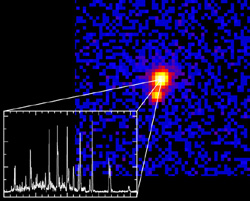October 18, 2000
CXC PR: 00-23
NASA's Chandra X-ray Observatory has found evidence that massive stars may be much more like the Sun than previously thought. Astronomers determined that magnetic loop structures, similar to those on the Sun, may exist on the surface of so-called O-type stars, some of the most luminous stars in the universe.
"This result is quite surprising," says Wayne Waldron of Emergent Information Technologies, Inc., and co-author of a paper submitted to the Astrophysical Journal Letters. "This bucks conventional wisdom to find that these stars may really resemble our Sun."
Using Chandra's High-Energy Transmission Grating Spectrometer (HETGS) in conjunction with a CCD X-ray camera, astronomers observed the star Zeta Orionis (one of the three belt stars in the constellation of Orion) and found strong X-ray line emission from ions of iron, oxygen, and other elements. The high-resolution X-ray spectrum enabled astronomers to determine that the X-ray emitting gas has a density 1000 times larger than predicted by current models, an amount comparable to the atmospheric density just above the surface of the star.
For many years, solar astronomers have derived densities of X-ray producing plasmas on the Sun using emission lines of ions like helium, those with just two bound electrons remaining. Chandra allows this approach to be used for other stars and it has detected X-rays from silicon ions that have been stripped of 12 of their usual complement of 14 electrons. This ion is an especially useful diagnostic of plasma densities in the extremely ultraviolet-bright environment surrounding O-stars.
Following the discovery of X-ray emission from O-class stars some 20 years ago, astronomers assumed that the X-rays were created in a hot corona near the star, similar to the Sun's corona. Those models were then abandoned in favor of the currently preferred explanation: the X-ray radiation is created by energetic shocks in the stellar winds (steady streams of matter ejected from many stars, including the Sun).
However, these new Chandra spectral data reveal a much higher density for the hot, X-ray producing gas than predicted if such shock models were correct. The Chandra observations also contradict current understanding since the team of researchers found no evidence of expansion in the emission lines – a fundamental prediction for shock models.
According to Waldron and co-author Joseph Cassinelli of the University of Wisconsin, Madison, their observations are best explained if the high density X-ray emission comes from confined structures of very hot plasma, similar to the magnetic loops found on the Sun. [For recent results on the Sun's magnetic loops, see the NASA HQ press release, "Fountains of Fire Illuminate Solar Mystery," issued September 26, 2000.]
A challenge for scientists will be to explain how these magnetic loops are generated and maintained. Although O-type stars have inner convection zones in their core, they are believed to lack outer convection zones, an ingredient scientists considered necessary to create such hot and energetic plasmas confined in magnetic loops. Convection zones are regions where most of the energy is transported by fluid motions from hotter regions to cooler ones. Without these zones being located near the stellar surface, astronomers are currently unable to explain how such high-densities knots of X-rays could exist.
O-type stars, often found in groups of similar stars known as "OB associations," are massive objects, which are typically 10 or more times the Sun's mass. These stars are known to have relatively short life spans, since they burn their nuclear fuel much faster than smaller stars.
The star Waldron and Cassinelli observed with Chandra, Zeta Orionis, is classified as an O "supergiant," which is 30 times larger, 30 times more massive, and radiates one hundred thousand times more energy than the Sun. The binary system of Zeta Orionis can be seen with the unaided eye from both Hemispheres for much of the year. Viewing them east to west, Zeta Orionis is the first star in the belt of the famous constellation of Orion, the Hunter.
The High Energy Transmission Grating Spectrometer was built by the Massachusetts Institute of Technology (MIT), Cambridge, MA. The Advanced CCD X-ray spectrometer (ACIS) X-ray camera was developed for NASA by Penn State and MIT. NASA's Marshall Space Flight Center in Huntsville, AL, manages the Chandra program. TRW, Inc., Redondo Beach, California, is the prime contractor for the spacecraft. The Smithsonian's Chandra X-ray Center controls science and flight operations from Cambridge, MA.
Images associated with this release are available on the World Wide Web at:
MEDIA CONTACTS
Steve Roy
Marshall Space Flight Center, Huntsville, AL
Phone: 256-544-6535
Megan Watzke
Chandra X-ray Observatory Center, CfA, Cambridge, MA
Phone: 617-496-7998



